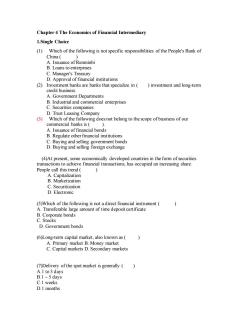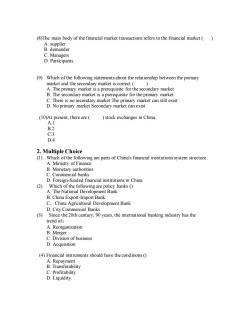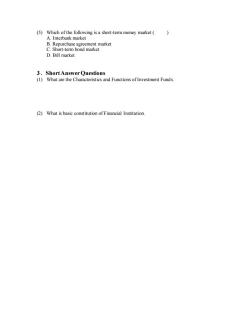同济大学:《货币金融学》课程教学资源(试卷习题)Chapter 4 The Economics of Financial Intermediary

Chapter 4 The Economics of Financial Intermediary 1.Single Choice (1)Which of the following is not specific responsibilities of the People's Bank of China() A.Issuance of Renminbi B.Loans to enterprises C.Manager's Treasury D.Approval of financial institutions (2)Investment banks are banks that specialize in ()investment and long-term cred it business. A.Government Departments B.Industrial and commercial enterprises C.Securities companies D.Trust Leasing Company (3) Which of the following does not belong to the scope of business of our commercial banks is () A.Issuance of financial bonds B.Regulate other financial institutions C.Buying and selling government bonds D.Buying and selling foreign exchange (4)At present,some economically developed countries in the form of securities transactions to achieve financial transactions,has occupied an increasing share. People call this trend A.Capitalization B.Marketization C.Securitization D.Electronic (5)Which of the following is not a direct financial instrument A.Transferable large amount of time deposit certificate B.Corporate bonds C.Stocks D.Government bonds (6)Long-term capital market,also known as A.Primary market B.Money market C.Capital markets D.Secondary markets (7)Delivery of the spot market is generally ( A.1 to 3 days B.1 ~5 days C.1 weeks D.1 months
Chapter 4 The Economics of Financial Intermediary 1.Single Choice (1) Which of the following is not specific responsibilities of the People's Bank of China ( ) A. Issuance of Renminbi B. Loans to enterprises C. Manager's Treasury D. Approval of financial institutions (2) Investment banks are banks that specialize in ( ) investment and long-term credit business. A. Government Departments B. Industrial and commercial enterprises C. Securities companies D. Trust Leasing Company (3) Which of the following does not belong to the scope of business of our commercial banks is ( ). A. Issuance of financial bonds B. Regulate other financial institutions C. Buying and selling government bonds D. Buying and selling foreign exchange (4)At present, some economically developed countries in the form of securities transactions to achieve financial transactions, has occupied an increasing share. People call this trend ( ) A. Capitalization B. Marketization C. Securitization D. Electronic (5)Which of the following is not a direct financial instrument ( ) A. Transferable large amount of time deposit certificate B. Corporate bonds C. Stocks D. Government bonds (6)Long-term capital market, also known as ( ) A. Primary market B. Money market C. Capital markets D. Secondary markets (7)Delivery of the spot market is generally ( ) A.1 to 3 days B.1 ~ 5 days C.1 weeks D.1 months

(8)The main body of the financial market transactions refers to the financial market ( A.supplier B.demander C.Managers D.Participants (9)Which of the following statements about the relationship between the primary market and the secondary market is correct ( A.The primary market is a prerequisite for the secondary market B.The secondary market is a prerequisite for the primary market C.There is no secondary market The primary market can still exist D.No primary market Secondary market can exist (10)At present,there are( )stock exchanges in China. A.1 B.2 C.3 D.4 2.Multiple Choice (1)Which of the following are parts of China's financial institutions system structure A.Ministry of Finance B.Monetary authorities C.Commercial banks D.Foreign-funded financial institutions in China (2)Which of the following are policy banks ( A.The National Development Bank B.China Export-Import Bank C.China Agricultural Development Bank D.City Commercial Banks (3)Since the 20th century,90 years,the international banking industry has the trend of: A.Reorganization B.Merger C.Division of business D.Acquisition (4)Financial instruments should have the conditions ( A.Repayment B.Transferability C.Profitability D.Liquidity
(8)The main body of the financial market transactions refers to the financial market ( ) A. supplier B. demander C. Managers D. Participants (9) Which of the following statements about the relationship between the primary market and the secondary market is correct ( ) A. The primary market is a prerequisite for the secondary market B. The secondary market is a prerequisite for the primary market C. There is no secondary market The primary market can still exist D. No primary market Secondary market can exist (10)At present, there are ( ) stock exchanges in China. A.1 B.2 C.3 D.4 2. Multiple Choice (1) Which of the following are parts of China's financial institutions system structure A. Ministry of Finance B. Monetary authorities C. Commercial banks D. Foreign-funded financial institutions in China (2) Which of the following are policy banks () A. The National Development Bank B. China Export-Import Bank C.China Agricultural Development Bank D. City Commercial Banks (3) Since the 20th century, 90 years, the international banking industry has the trend of: A. Reorganization B. Merger C. Division of business D. Acquisition (4) Financial instruments should have the conditions () A. Repayment B. Transferability C. Profitability D. Liquidity

(5)Which of the following is a short-term money market ( A.Interbank market B.Repurchase agreement market C.Short-term bond market D.Bill market 3 Short Answer Questions (1)What are the Characteristics and Functions of Investment Funds. (2)What is basic constitution of Financial Institution
(5) Which of the following is a short-term money market ( ) A. Interbank market B. Repurchase agreement market C. Short-term bond market D. Bill market 3、Short Answer Questions (1) What are the Characteristics and Functions of Investment Funds. (2) What is basic constitution of Financial Institution
按次数下载不扣除下载券;
注册用户24小时内重复下载只扣除一次;
顺序:VIP每日次数-->可用次数-->下载券;
- 同济大学:《货币金融学》课程教学资源(试卷习题)Chapter 3 Interest and Interest Rate.docx
- 同济大学:《货币金融学》课程教学资源(试卷习题)Chapter 2 Credit and Financial Instruments.docx
- 同济大学:《货币金融学》课程教学资源(试卷习题)Chapter 1 Money and Monetary System.docx
- 同济大学:《货币金融学》课程教学资源(大纲教案)教学大纲 The Economics of Money and Banking.pdf
- 吉林大学:《财政学》课程教学资源(试卷习题)远程教育考试样卷(无答案).doc
- 吉林大学:《经济法》课程电子教案(PPT教学课件,共十三章,授课对象:远程教育,授课教师:孙凤英).ppt
- 《财务管理》课程教学资源(专项报告)南宁市宾阳县生猪现代农业产业园实施方案(简版).pdf
- 《财务管理》课程教学资源(专项报告)存栏1120头商品猪养殖小区可行性研究报告(简版).pdf
- 《财务管理》课程教学资源(专项报告)存栏2000头祖代原种猪场可行性研究报告(简版).pdf
- 《财务管理》课程教学资源(专项报告)存栏3000头曾祖代原种猪场环保生态养殖综合开发项目可研报告(简版).pdf
- 《财务管理》课程教学资源(专项报告)存栏5000头基础母猪现代化生猪养殖场可行性研究报告(简版).pdf
- 《财务管理》课程教学资源(专项报告)山西灵空山国家级自然保护区2016年林业国家级自然保护区补助资金建设项目可行性研究报告(简版).pdf
- 《财务管理》课程教学资源(专项报告)森林康养度假建设项目可行性研究报告(简版).pdf
- 山西农业大学:《财务管理》课程教学资源(试卷习题)财务管理期末考试模拟题三及答案.pdf
- 山西农业大学:《财务管理》课程教学资源(试卷习题)财务管理期末考试模拟题二及答案.pdf
- 山西农业大学:《财务管理》课程教学资源(试卷习题)财务管理期末考试模拟题一及答案.pdf
- 山西农业大学:《财务管理》课程教学资源(试卷习题)第八章 利润分配管理(含答案).pdf
- 山西农业大学:《财务管理》课程教学资源(试卷习题)第七章 营运资金管理(含答案).pdf
- 山西农业大学:《财务管理》课程教学资源(试卷习题)第五章 固定资产投资(含答案).pdf
- 山西农业大学:《财务管理》课程教学资源(试卷习题)第四章 筹资(含答案).pdf
- 同济大学:《货币金融学》课程教学资源(试卷习题)Chapter 5 Commercial Banks.docx
- 同济大学:《货币金融学》课程教学资源(试卷习题)Chapter 6 Central Banks.docx
- 同济大学:《货币金融学》课程教学资源(试卷习题)Chapter 7 Financial Markets.docx
- 同济大学:《货币金融学》课程教学资源(试卷习题)Chapter 8 Money Supply and Money Demand.docx
- 同济大学:《货币金融学》课程教学资源(试卷习题)Chapter 9 Money and Inflation.docx
- 同济大学:《货币金融学》课程教学资源(试卷习题)Answers for Test Sample(参考答案)Chapter 1-10.docx
- 同济大学:《货币金融学》课程电子教案(课件讲稿)Chapter 1 Introduction(负责人:郭英).pdf
- 同济大学:《货币金融学》课程电子教案(课件讲稿)Chapter 2 Money and Monetary System.pdf
- 同济大学:《货币金融学》课程电子教案(课件讲稿)Chapter 3 Credit and Financial Instrument.pdf
- 同济大学:《货币金融学》课程电子教案(课件讲稿)Chapter 4 Interest and Interest Rate.pdf
- 同济大学:《货币金融学》课程电子教案(课件讲稿)Chapter 5 Financial Institutions.pdf
- 同济大学:《货币金融学》课程电子教案(课件讲稿)Chapter 6 Commercial Banks.pdf
- 同济大学:《货币金融学》课程电子教案(课件讲稿)Chapter 7 Central Banks.pdf
- 同济大学:《货币金融学》课程电子教案(课件讲稿)Chapter 8 Financial Markets.pdf
- 同济大学:《货币金融学》课程电子教案(课件讲稿)Chapter 10 Monetary Policy.pdf
- 同济大学:《货币金融学》课程电子教案(课件讲稿)Chapter 9 Money Demand and Money Supply.pdf
- 同济大学:《货币金融学》课程电子教案(课件讲稿)Chapter 11 Inflation and Deflation.pdf
- 吉林大学:《会计学》课程电子教案(PPT课件)第一章 绪论(负责人:孙烨).ppt
- 吉林大学:《会计学》课程电子教案(PPT课件)第二章 帐户与复式记帐.ppt
- 吉林大学:《会计学》课程电子教案(PPT课件)第三章 分录与记帐.ppt
